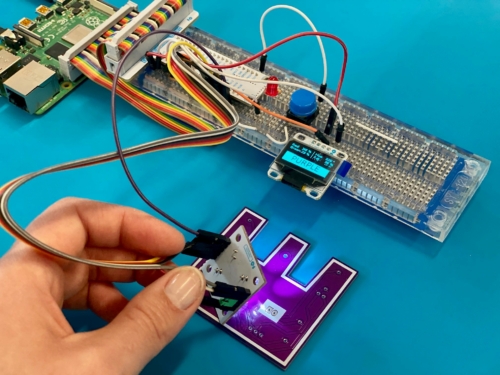It’s April fool’s day! And it’s never too late to make a fun project, especially when said project is a fart machine! This little invention includes a force sensing resistor that triggers a speaker when sat upon. So make sure to hide the sensor as good as possible and have fun!
Skill level: tricky
Here’s what you need:
- PLA in any color you like
- Atmega 328 NANO or other Arduino based microcontroller of this size
- 1x SD-card Logging shield (VMA304)
- 1x audio amplifier (MM209)
- 1x force sensing resistor (VMA334)
- 1x SD -card
- 1 x 10K resistor (K/RES-E12)
- 9V battery + connector
- 1 x speaker ± dia 57mm (MK177 – 1W/Ω 8 or any other)
- 1 x eurocard (B/ECI)
- jumper wires (VMA427)
- soft electrical wires (preferably in a color that matches the chair upon which you wish to bestow the prank)
- USB A to Mini B cable
- external power supply (5V, 1A)
- strap (not necessary)
- 4 x dia 3x20mm screws
- 2 x dia 3x5mm screws
Tools:
- 3D printer
- soldering iron
- solder
- shrink tubes (about 25 small pieces)
- heat gun or hair dryer
- hot glue gun or super glue
2. 3D PRINT the case
Step 1: download the .stl files of the fart machine on our Thingiverse account.
Step 2: slice the .stl files in the compatible software for your 3D printer. You can use Ultimaker cura for your Vertex Delta (there’s a different Repetier version for each Vertex!). Please note: do not adjust the size of the case in your slicer software! These are our print settings for the case:
rafts: none
support: no
resolution: 0.2mm
infill: 25%
filament: PLA
3. SAVING AUDIO FILES ON THE SD -CARD
You can download the fart sound that we used here.
Or you can put your own files on the SD- card. Make sure they are in .wav format! You can convert the files online.
4. PREPPING THE ELECTRONICS AND PROGRAMMING YOUR ARDUINO
Step 1: connect the Arduino Nano with the modules by connecting the wires as shown in the wiring diagram below. We recommend to do this first on a prototyping breadboard before you solder!
Step 2: download the example code here and upload it onto your Arduino.
Not familiar with Arduino yet? Check out their ‘Getting Started’ page here and learn how to program your microcontroller.
Step 3: afterward, check if everything works by connecting it to a 9V power supply.

5. CONNECTING THE ELECTRONICS
It’s solder time!
Warnings! Keep in mind the placement of all modules in the casing of the fart machine. If the wires are too short or too long, the modules may not fit properly.
Also, it is important to get a good electrical connection between the wires. Therefore, it is advised to put heat shrinks around every solder connection, this will prevent electrical failures. Here’s how we’ll go to work:
Step 1: (optional) Place a strap through the provided slots (this will make it easier to fix the machine underneath a chair).

Step 2: Screw the SD- card reader as shown in the picture, pay attention to the position of the slot.

Step 3: Solder a piece of an eurocard onto the pins of the Nano. (This will make it easier to connect because we have multiple GND and 5V connections)


Step 4: Start soldering a wire on all the pins of the SD-card reader. Finish the connections off with a heat shrink.

Step 5: Then start soldering the wires from the SD-card reader to the Arduino Nano according to the connection scheme above.

Step 6: Now connect the force sensing resistor. Make sure your wires are long enough (this part will lay on the seat of a chair).

Step 7: Now start connecting the amplifier, don’t connect the speaker yet!

Step 8: Place the speaker in the provided hole of the case and fixate it with glue or hot glue.

Step 9: Now connect the speaker with the amplifier.

Step 10: The next step is to solder the 9V battery connector to the Vin and GND of the Arduino Nano.

Step 11: Click the battery on the connector and place the battery in the case.

Step 12: Screw the case together as shown in the picture.

Step13: Plug in an SD-card with the fart sound on (download it above). Check out the pictures below to see how we secured it to a chair.


DONE! Check out the pictures below to see how we secured it to a chair.
Either use the strap or double-sided tape to fixate the case onto the bottom of a chair.

Guide the wires of the force sensing resistor to the top of the seat. Cover it with some black tape or guide it underneath the fabric and wait for it …





